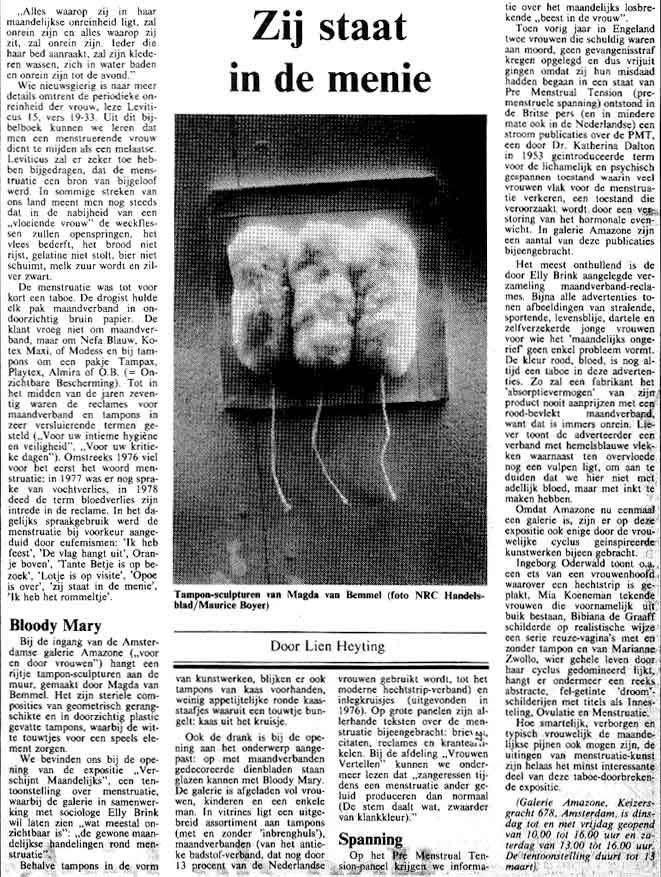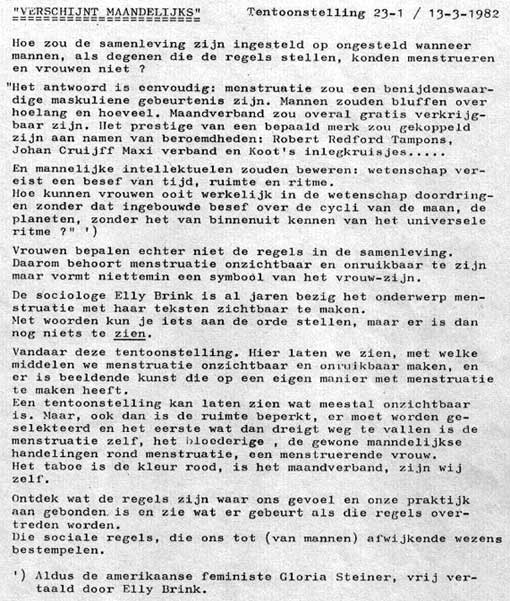Below is Harry Finley's translation
of the NRC Handelsblad newpaper article, on top:
She's painted red
by Lien Heyting
"Everything upon which she lies during her monthly impurity shall
be unclean; everything also upon which she sits shall be unclean. And whosoever
touches her her bed shall wash his clothes, and bathe himself in water,
and be unclean until the evening."
If you're curious about more details about the periodic impurity of the
woman, read Leviticus 15, verses 19-33. [Read here
on the MUM site.] From the Bible we learn that one avoids menstruating women
like a leper. Leviticus certainly contributed to menstruation's being a
source of superstition. In some parts of our country [the Netherlands] people
still believe that the proximity of a "flowing woman" cause preserves
jars to burst, meat to spoil, bread not to rise, gelatin not to set, beer
not to foam, milk to sour and becoming silver black. [Read about menstrual
poison - menotoxin.]
Until recently menstruation was a taboo. The druggist wrapped each pack
of menstrual pads in brown paper. The customer didn't ask for menstrual
pads but for Nefa Blauw [see an ad], Kotex Maxi,
or Modess, and with tampons for a pack of Tampax [Dutch
ad], Playtex, Almira or O.B (= "Invisible Protection") [this
is incorrect and a long-standing misinterpretation in the Netherlands; it
really stands for "ohne Binde" - without a pad - in German, the
language of the country where the brand started, Germany; more information
here]. Until the middle of the 1970s the ads for
pads and tampons were worded in very veiled terms ("For your intimate
hygiene and security," "For your critical days"). About 1976
the word menstruation appeared for the first time; in 1977 there was still
talk of loss of moisture; in 1978 the word blood loss [one word in Dutch]
appeared in ads. In daily speech menstruation was preferably indicated by
euphemisms: "I'm having a feast," "The flag's hanging out,"
"Orange above," [I believe both of these refer to the Dutch monarchy
House of Orange], "Aunt Betty is visiting," "Lotje is visiting,"
"Granny is here," "She's painted red," "I have
the rubbish." [Read more Dutch euphemisms.]
Bloody Mary
At the entrance to the Amsterdam gallery "Amazon" ("For
and by women") hangs a torn tampon sculpture on the wall made by Magda
van Bemmel. The sterile composition of geometrically arranged tampons are
in transparent plastic mountings, on which the white strings supply a playful
element.
We're at the opening of the show "Appears Monthly," an exhibit
about menstruation, whereby the gallery in conjunction with sociologist
Elly Brink demonstrates "what's mostly invisible": "the usual
monthly goings-on around menstruation."
Besides tampons in the form of of art works, there are also cheese tampons,
little appetizing round cheese sticks out of which strings dangle: cheese
from the crotch.
The drinks are also appropriate to the occasion: on the dinner trays
decorated with menstrual pads are glass mugs with Bloody Marys. The gallery
is packed full of women, children and a single man. In glass cases lie a
wide assortment of tampons (with and without applicators), menstrual pads
(from the antique terry cloth pad [see an Italian
version], still used by 13 percent of Dutch women to the modern adhesive
strip pad) and panty pads (invented in 1976). All kinds of texts about menstruation
lie on big panels: quotes from letters, ads and newspaper articles. In the
section "Women speak" we can among other things read that during
menstruation singers voices' change (the voice drops a little, heavier in
timbre).
Tension
On the premenstrual syndrome [PMS] panel we get information about the
monthly letting loose of the "beast in the woman."
When last year in England two women who committed murder got no jail
time because their crime had been committed when they had PMS there was
a stream of publicity in the British press (and to a lesser extent in the
Dutch press) about the condition, named premenstrual syndrome by Dr. Katherine
Dalton in 1953 for the physical and psychological tension caused by the
upsetting of the hormonal balance. There are a number of these articles
in Gallery Amazon.
The most revealing is Elly Brink's collection of menstrual pad ads. Almost
all the ads show pictures of beaming, joyful, athletic, playful, self-confident
young women for whom the "monthly trouble" poses no problem. The
color red, blood, is always taboo in these ads. A manufacturer should never
commend the absorption ability with a red-stained menstrual pad, for isn't
that color always unclean? The advertiser shows rather a pad with sky-blue
spots next to which a dripping fountain pen lies in order to show that we
are dealing not with royal blood but with ink.
Because Amazon is a gallery there are some art works inspired by the
woman's cycle. [See the menstrual art on this site.]
Ingeborg Oderwald show among other things an etching of a woman's head
with a with an adhesive strip stuck on it, Mia Koeneman draws women that
are mostly composed of bellies, Bibiana de Graaff realistically depicts
a series of super vaginas with and without tampons, and from Marianne Zwollo,
there hangs a series of abstract, gaudily toned "dream" pictures
with titles like Inner Scaffolding, Ovulation and Menstruation.
However painful, secret and typically female the monthly troubles may
be, the expressions of menstruation art are unfortunately the least interesting
part of this taboo-breaking exhibit.
| 




